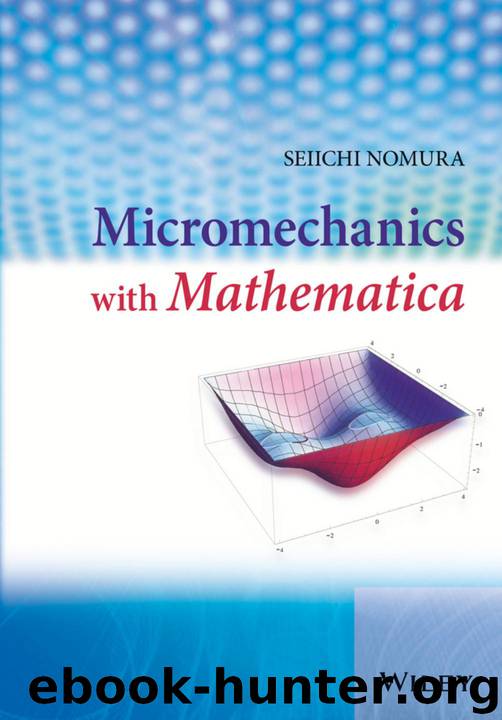Micromechanics with Mathematica by Seiichi Nomura

Author:Seiichi Nomura [Nomura, Seiichi]
Language: eng
Format: epub
Published: 2016-02-18T03:33:47+00:00
Trim Size: 170mm x 244mm
Nomura
c03.tex
V3 - 02/10/2016
4:53 P.M.
Page 132
k
132
Micromechanics with Mathematica
The strain field in the matrix is lengthy and part of the expressed is listed as
3.2.6
Exact Solution for Four-Phase Materials
The analysis for a four-phase material where a spherical inclusion is surrounded by two extra
coating layers embedded in an infinite matrix as shown in Figure 3.12 is straightforward following the procedure described earlier. As the solution procedure is spelled out in the previous
subsection, this problem is an exercise of the employed method. As expected, the analytical
solution of the elastic field for such a material is expected to be extremely large, which is
verified by an output from Mathematica. This inevitably poses a fundamental question of how
k
useful an analytical solution is over a numerical solution if the length of the analytical solution
k
is too large, which is only traceable by computer.
Nevertheless, analytical solutions are desirable when used in parametric study that requires
all the relevant parameters to be present. In this subsection, instead of printing the output from
each process, only the logic and the corresponding Mathematica code are shown. The complete
program and its output can be downloaded from the companion web page.
Xij
a 2
X
a
ij
1
( μ 1, λ 1) ( μ 2, λ 2)
( μ 3, λ 3)
( μ , λ )
m
m
Xij
Figure 3.12
Four-phase material
k
Trim Size: 170mm x 244mm
Nomura
c03.tex
V3 - 02/10/2016
4:53 P.M.
Page 133
k
Inclusions in Infinite Media
133
3.2.6.1
Exact Solution for X
The general form of the displacement and traction when a body is subject to X at the far field
can be expressed as
Using the aforementioned expression, the displacement and the traction at each phase can
be expressed as
k
k
where the numbers “1–3” refer to the inclusion and the two layers and “m” refers to the matrix.
The unknown coefficients are denoted as c1[1]–c1[4], c2[1]–c2[4], c3[1]–c3[4], and
cm[1]–cm[4]. From the requirement that ui must remain finite at r = 0, it follows that c1[1]
= 0. From the requirement that 𝜖 → ̂
ij
Xij as r → ∞, it follows that cm[2] = 1. Therefore,
the continuity condition for the displacement and the traction at r = a 1, r = a 2, and r = a 3 are entered as
The displacement, strain, stress, and traction for each phase are now computed from the fol-
lowing code:
k
Trim Size: 170mm x 244mm
Nomura
c03.tex
V3 - 02/10/2016
4:53 P.M.
Page 134
k
134
Micromechanics with Mathematica
The strain inside the inclusion, 𝜖 1, can be expressed as
ij
k
k
The strains in the second and third layers are expressed as
k
Trim Size: 170mm x 244mm
Nomura
c03.tex
V3 - 02/10/2016
4:53 P.M.
Page 135
k
Inclusions in Infinite Media
135
The strain in the matrix is expressed as
3.2.6.2
Exact Solution for X′ ij
The Mathematica code is shown next but without output in this subsection, as the typical output
is too long. The displacement (Disp1–Dispm) and the traction (Tract1–Tractm) in each of
the four phases are set up first. Here, the numbers 1–3 refer to the material properties of the
inclusion and the surrounding two coating materials, and “m” refers to the matrix. They are
assumed to contain unknown coefficients (c1[i]–cm[i]) for each phase.
k
k
The following code sets up the equations for the unknowns (c1[i]–c4[i]) by applying the con-
tinuity conditions across each phase for the displacement and the traction. As
Download
This site does not store any files on its server. We only index and link to content provided by other sites. Please contact the content providers to delete copyright contents if any and email us, we'll remove relevant links or contents immediately.
| Automotive | Engineering |
| Transportation |
Whiskies Galore by Ian Buxton(41523)
Introduction to Aircraft Design (Cambridge Aerospace Series) by John P. Fielding(32881)
Small Unmanned Fixed-wing Aircraft Design by Andrew J. Keane Andras Sobester James P. Scanlan & András Sóbester & James P. Scanlan(32567)
Craft Beer for the Homebrewer by Michael Agnew(17926)
Turbulence by E. J. Noyes(7690)
The Complete Stick Figure Physics Tutorials by Allen Sarah(7134)
Kaplan MCAT General Chemistry Review by Kaplan(6582)
The Thirst by Nesbo Jo(6431)
Bad Blood by John Carreyrou(6270)
Modelling of Convective Heat and Mass Transfer in Rotating Flows by Igor V. Shevchuk(6218)
Learning SQL by Alan Beaulieu(6023)
Weapons of Math Destruction by Cathy O'Neil(5818)
Man-made Catastrophes and Risk Information Concealment by Dmitry Chernov & Didier Sornette(5638)
Digital Minimalism by Cal Newport;(5382)
Life 3.0: Being Human in the Age of Artificial Intelligence by Tegmark Max(5181)
iGen by Jean M. Twenge(5149)
Secrets of Antigravity Propulsion: Tesla, UFOs, and Classified Aerospace Technology by Ph.D. Paul A. Laviolette(4972)
Design of Trajectory Optimization Approach for Space Maneuver Vehicle Skip Entry Problems by Runqi Chai & Al Savvaris & Antonios Tsourdos & Senchun Chai(4837)
Electronic Devices & Circuits by Jacob Millman & Christos C. Halkias(4739)
